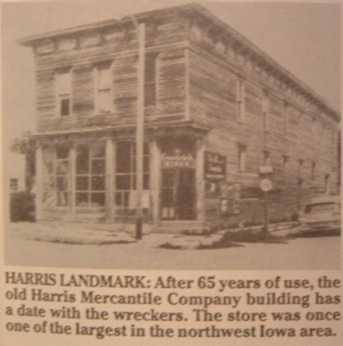
The Harris Centennial
Harris --The past 100 Years
Harris Mercantile
Page 41-42
Once Famed Store on Harris Main Street ‘Lives
Out’ Last Days
By Lew Hudson

Harris – The largest business building in Harris, once the
pride of the village, has reached the end of the road.
After 65 years of varied service to the community the former
Harris Mercantile Company building has been sold by J. T.
Purviance to Ray Otterbein, who farms northeast of Hartley.
Otterbein will tear the building down, consigning the usable
lumber to serve out its remaining life as parts of farm
buildings.
THE BUILDING is slowly coming apart at the seams
anyway. Siding sags, windows are shattered, paint is long since
gone, and the entire building has a pronounced list, the result
of time and the incessant prairie winds.
It was not always so. At one time the building housed one of the
fanciest department stores in northwest Iowa on the first floor,
and a theater and community meeting hall on the second. It was a
building with real style; although architectural tastes have
changed somewhat in the years since it was designed.
While early history is a little hazy, it is thought that the
store was built in 1898 by C. W. and W. C. Grant, who bought the
land from John and Charles Wernstrum, who acquired it in 1883
from the Sioux City and St. Paul Railroad Company. The railroad
purchased the land in 1877, from the state of Iowa, which in turn
had inveigled it away from its original owners, the Indians.
Old timers can still remember shopping at the store for the
latest fashions in hats, blouses, dresses, shoes and other items
“fresh from the East.” Upstairs, early silent movie
thrillers flickered on the screen in the theater section. It was
the showplace of Osceola County in more ways than one.
SHORTLY BEFORE World War I, the store was
acquired by J. L. and Mary Seeley, who operated it as a
partnership with J. H. and P. W. Maher. The Seeleys were
prominent business people in Round Lake. The Mahers lived in
Harris and operated the store.
A booklet, published in 1914, described the owners as
“persons who came up from the bottom in the ranks of western
Iowa businessmen and reached the top of the ladder.” The
booklet describes their stock as “a complete line of dry
goods, groceries, clothing, shoes, dress goods, cloaks, notions,
crockery, etc.” and proclaimed the business as “one of
the largest in the entire community.”
Later owners of the store included D. L. Nicol, Claude J. De St.
Poer, P.W. and Joe Maher, William and Lillian Seebode, and Carl
Rahn. The last owner, J. T. Purviance, bought the store in 1937,
after the mercantile and grocery stock was sold out. He operated
an implement business in the building until two years ago when he
retired. The remaining stock of parts and hardware will be
disposed of at a public auction August 27.
THERE ARE a lot of memories wrapped up in the
building. Dances and shows were held upstairs. Orchestras and
small musical groups from throughout the northwest part of Iowa
and southwest Minnesota played regular dance dates there. Regular
movies of the Pearl White serial type were scheduled to the
delight of citizens who had little other chance to enjoy
commercial entertainment.
Mrs. E. L. McFarland of Harris recalls attending a July Fourth
celebration in town. She still remembers eating a picnic dinner
in the partially completed store building.
Mrs. Ida Wentler of Harris hasn’t forgotten the time in the
early years of the century when she was doing baking for a number
of families in town. She went to the “big store” for
some flour only to find that they were temporarily out. With
customers waiting, Mrs. Wentler and a friend, Mary Bigelow, who
was a dressmaker, had to get in a buggy and drive to Lake Park
and back with two 50-pound sacks. “The brand was Omar,”
she said.
Demolition has not yet begun. When it does, it shouldn’t
take long to remove what is left of the old landmark. Several
years ago, the equipment in the movie theater was moved out. At
that same time, a floor of solid white birch was ripped up and
sold.
DOWNSTAIRS, A few aging light fixtures will be
all that is left as soon as the auction sale is held. The
building itself is so tired it shouldn’t take much work to
flatten it.
When it is gone, it will signal the end of a complete block of
business buildings. Preceding it to the rubble heap has been the
old G. L. Wernstrum Merchant’s Hotel and Restaurant and the
Harris Harness Shop next door, operated by J. M. Renn.
Within weeks the Harris Mercantile Company will be gone forever.
It will take much longer than that however, for the memories to
disappear. Memories take on luster with the passing of years.
Buildings are just the opposite.